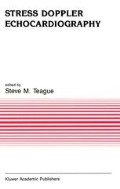Abstract
It has been over a decade since the initial studies confirming that transcutaneous Doppler ultrasound could be used to accurately assess ascending aortic blood flow velocities [1–3]. As described in detail elsewhere in this book, a number of parameters derived from the aortic velocity profile accurately reflect global left ventricular systolic function (Figure 1). In fact, Doppler evaluation of aortic blood flow velocities provides one of the few non-invasive methods by which beat-to-beat changes in left ventricular function may be assessed.
Access this chapter
Tax calculation will be finalised at checkout
Purchases are for personal use only
Preview
Unable to display preview. Download preview PDF.
References
Light H. Transcutaneous aortovelography. British Heart Journal 1976; 38:433–442.
Huntsman LL, Gams E, Johnson CC, Fairbanks E. Transcutaneous determination of aortic blood flow velocities in man. Am Heart J 1975; 89:605–612.
Angelsen BAJ, Brubakk AO. Transcutaneous measurement of blood flow velocity in the human aorta. Cardiovasc Res 1976; 10:368–379.
Steiningart RM, Meller J, Barovick J, Patterson R, Herman MV, Teichholz LE. Pulsed Doppler echocardiographic measurement of beat-to-beat changes in stroke volume in dogs. Circulation 1980; 62:542–548.
Magnin PA, Stewart JA, Myers S, VonRamm O, Kisslo JA. Combined Doppler and phased array echocardiographic estimation of cardiac output. Circulation 1981; 63:388–392.
Goldberg SJ, Sahn DJ, Allen HD, Valdes-Cruz LM, Hoenecke H, Carnahan Y. Evaluation of pulmonary and systemic blood flow by 2-dimensional Doppler echocardiography using fast fourier transform spectral analysis. Am J Cardiol 1982; 50:1394–1400.
Labovitz AJ, Buckingham TA, Habermehl K, Nelson J, Kennedy HL, Williams GA. The effects of sampling site on two-dimensional Echo-Doppler determination of cardiac output. Am Heart J 1985; 109:327–332.
Gardin JM, Iseri LT, Elkayam U, Tobis J, Childs W, Burn CS, Henry WL. Evaluation of dilated cardiomyopathy by pulsed Doppler echocardiography. Am Heart J 1983; 106:1057–1065.
Sabbah HN, Khaja F, Brymer JF, McFarland TM, Albert DE, Snyder JE, Goldstein S, Stein PD. Noninvasive evaluation of left ventricular performance based on peak aortic blood acceleration measured with a continuous-wave Doppler velocity meter. Circulation 1986; 74:323–329.
Mehta N, Bennett DE. Impaired left ventricular function in acute myocardial infarction assessed by Doppler measurement of ascending aortic blood velocity and maximum acceleration. Am J Cardiol 1986; 57:1052–1058.
Elkayam U, Gardin JM, Berkley R, Hughes CA, Henry WL. The use of Doppler flow velocity measurement to assess the hemodynamic response to vasodilators in patients with heart failure. Circulation 1983; 67:377–383.
Rose JS, Nanna M, Rahimtoola SH, Elkayam U, McKay C, Chandraratna PA. Accuracy of determination of changes in cardiac output by transcutaneous continuous-wave Doppler computer. Am J Cardiol 1984; 54:1099–1101.
Keren G, Bier A, Strom AJ, Laniado S, Sonnenblick EH, LeJemtel TH. Dynamics of mitral regurgitation during nitroglycerin therapy: A Doppler echocardiographic study. Am Heart J 1986; 112:517–525.
Wallmeyer K, Wann LS, Sagar KB, Kalbfleisch J, Klopfenstein HS. The influence of preload and heart rate on Doppler echocardiographic indexes of left ventricular performance: comparison with invasive indexes in an experimental preparation. Circulation 1986;74:181–186.
Harrison MR, Smith MD, Nissen SE, Grayburn PA, DeMaria AN. Use of exercise Doppler echocardiography to evaluate cardiac drugs: effects of Propranolol and Verapamil on aortic blood flow velocity and acceleration. J Am Coll Cardiol 1988; 11:1002–1009.
Author information
Authors and Affiliations
Editor information
Editors and Affiliations
Rights and permissions
Copyright information
© 1990 Kluwer Academic Publishers
About this chapter
Cite this chapter
Labovitz, A.J. (1990). Pharmacologic Doppler stress testing in coronary artery disease. In: Teague, S.M. (eds) Stress Doppler Echocardiography. Developments in Cardiovascular Medicine, vol 105. Springer, Dordrecht. https://doi.org/10.1007/978-94-009-0477-4_13
Download citation
DOI: https://doi.org/10.1007/978-94-009-0477-4_13
Publisher Name: Springer, Dordrecht
Print ISBN: 978-94-010-6700-3
Online ISBN: 978-94-009-0477-4
eBook Packages: Springer Book Archive

